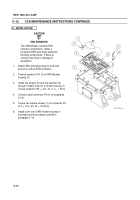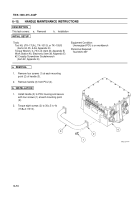TM-9-1200-215-34-P - Page 159 of 266
TM 9–1200–215–34&P
6–5
(2)
Circuit breakers. Every connector, except the diagnostic connector, in the PCU has a circuit breaker that
is tripped when an over–current situation occurs. The circuit breakers are sized to provide the current needed for
the maximum power level of the device. The dual power buses have one breaker per bus. If one bus breaker
trips, the AFCS can function on the redundant bus.
The vehicle power circuit breaker protects the internal wiring in the PCU in case of an overload condition. Each of
the back–up batteries that support the PCU are connected to a circuit breaker. The breakers protect the back–up
batteries, the interconnect cable, and the PCU in the event of an overload condition on the back–up batteries or a
short circuit within the PCU.
The PCU provides unconditioned vehicle power to components outside the AFCS. The voltage is unconditioned
but passes through a circuit breaker for each of these components.
(3)
Transient voltage suppressors. The input power to the PCU may see spikes of
"
250 volts for a duration
of 0.1 milliseconds. The filter assembly that shields the vehicle input connector contains transient voltage
suppressors that clip the
"
250 volt spikes to less than 100 volts.
(4)
EMI filters. The input power to the PCU passes through a filter assembly to keep the external EMI from
entering the system and to keep noise generated in the AFCS from entering the vehicle power system. Mounted
on the cover of the assembly are feed–through filters. These filters are
π
section low pass EMI filters that allow
the DC power to pass through while filtering the high frequency noise. The radio filter assembly contains the
same filtering scheme to keep noise generated by the radios from entering the PCU and the rest of the power
system. The PCU contains another
EMI filter on the output side of the conditioner to achieve additional filtering
capabilities before it is distributed to the system.
(5)
Power–up relays. The PCU is controlled by an external magnetically held toggle switch. A low current
voltage line, ‘SWITCH VOLTAGE’, is routed from the PCU through the dual power busses to the
toggle switch.
This line has a potential nearly equal to the vehicle battery voltage even when the AFCS is off, except in the case
of a nuclear event. When the PCU senses the closing of the toggle switch, (‘ON’ signal switches from low voltage
to high voltage) both power relays in the
PCU are activated and the PCU supplies output power. The toggle
switch will not turn the system on unless there is at least 16 Vdc provided to the PCU’s input connector to prevent
the PCU from powering up on its back–up battery assemblies alone.
The toggle switch will be held in the “on” position until the operator turns the system off or the PCU receives a
‘SHUTDOWN’ signal or the Nuclear Event Detector (NED) triggers a shutdown. If one of these three conditions is
met then the PCU opens a relay to interrupt power on the ‘SWITCH VOLTAGE’ signal and the toggle switch will
return to its normally “off” position.
When the toggle switch is “off” no power will be provided to the AFCS, but the radio rack will continue to receive
power. A power diode bypasses the input circuit breaker and power relay to supply power to the vehicle’s radios
when the AFCS is off. This power will be unsupported power from the slip–rings but it will pass through the input
EMI filter assembly. The power diode protects the radios from negative voltage transients.
(6)
Input power loss support circuit. Input vehicle power to the PCU has a steady state range of 25 to 30
volts for a fault free condition with a combined generator–vehicle battery power supply and 20 to 27 volts for a
vehicle battery only condition.
The PCU supports undervoltage transients by using the back–up batteries which have a nominal 14 volts on each
assembly. Two back–up battery assemblies are connected in parallel to form a 14 volt, 50 amperehour battery.
The PCU utilizes a switching transformer and two diodes to double the battery voltage to 28 volts. The controller
is a Pulse Width Modulator (PWM) which drives two banks of n–channel Metal Oxide Semi–conductor Field Effect
Transistors (MOSFETs) that switch the high currents in the transformer. The output
of the voltage doubler is then
filtered and connected to the PCU conditioned power output for system distribution. The voltage doubler block
diagram is shown in figure 6–3.
Back to Top




















